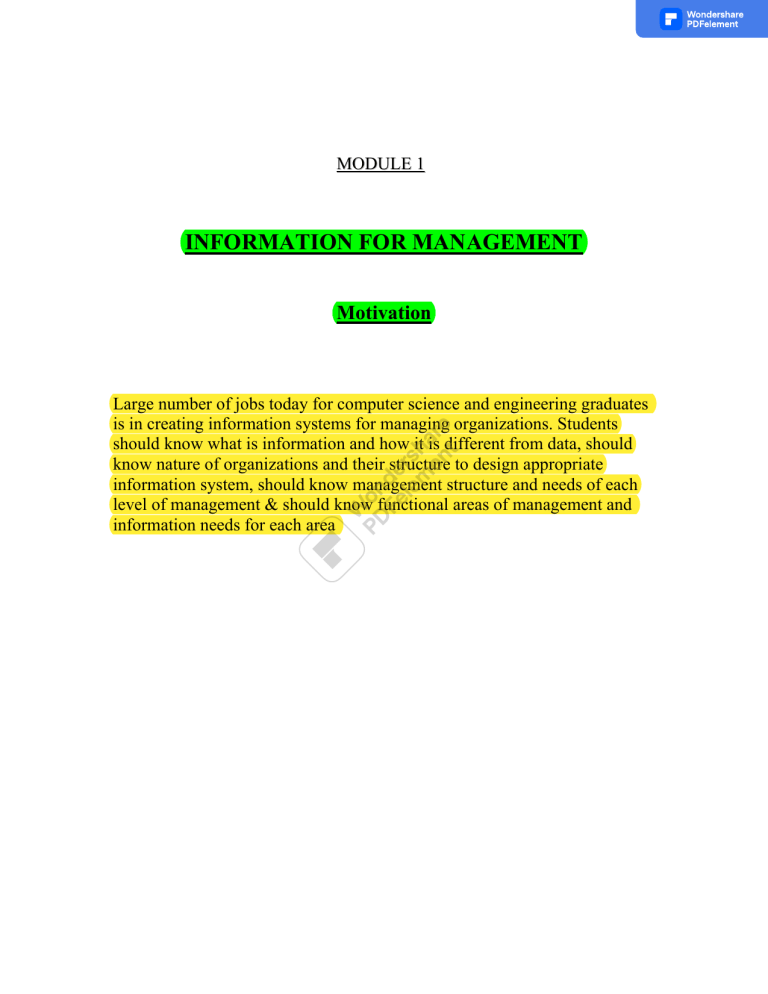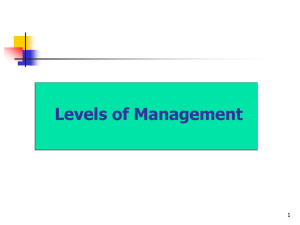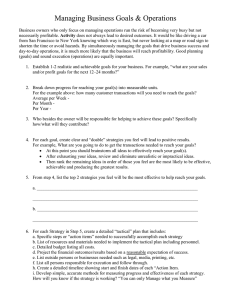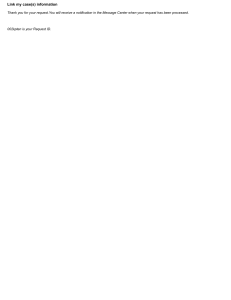
MODULE 1 INFORMATION FOR MANAGEMENT Motivation Large number of jobs today for computer science and engineering graduates is in creating information systems for managing organizations. Students should know what is information and how it is different from data, should know nature of organizations and their structure to design appropriate information system, should know management structure and needs of each level of management & should know functional areas of management and information needs for each area LEARNING UNIT 1 Data and Information, types of information : Operational, tactical, strategic, Statutory DATA AND INFORMATION DATA is a raw material with which we begin. Collecting data costs money and hence one must collect necessary and sufficient data. Data is generally used by machines and is useless unless it is processed to create INFORMATION. INFORMATION is Processed data, used by managers to initiate actions and to run the organization efficiently. The data processed by machines gives information TYPES OF INFORMATION STRATEGIC : Needed for long range planning and directions. This is less structured. TACTICAL : Needed to take short range decisions to improve profitability and performance. OPERATIONAL : Needed for day to day operations of the organization. Eg: Daily Sales, Billing. STATUTORY : Needed by law to sent to government authorities. Eg: Sales tax return. MANAGEMENT HIERARCHY AND INFORMATION NEEDS Volume of Information Type of Information Low condensed Unstructured Medium moderately processed Moderately structured Large Detailed Reports Highly structured Top Managers Middle Managers Line managers StrategicLong range planning Tactical Short range improvement Operational Day to day policies LEARNING UNIT 2 Why do we need information systems, management structure, requirements of information at different levels of management NEED FOR INFORMATION SYSTEMS Information systems are needed when timely processing for fast action is needed, same data has to be processed in different ways and when organizations require innovative processing. MANAGEMENT STRUCTURE Chief Executive (Strategical) Production manager Marketing manager Materials manager Line managers Functional areas of management are as follows: Finance manager Human Resource manager PRODUCTION MARKETING MATERIALS – purchase, stores FINANCE –Accounts HUMAN RESOURCE DEVELOPMENT(HRD) RESEARCH AND DEVELOPMENT (R&D) INFORMATION FOR MANAGEMENT A Production Management The following type of information is needed in production management: Strategic Information: 1)Yearly and monthly production quotas and alternate schedules 2)Policies on machine replacement, augmentation and modernization. 3)Identifying best product mix. Tactical Information 1)Identifying and controlling areas of high cost. 2) Identifying critical bottlenecks in production. 3) Identifying alternate production schedules based on tools, machines etc. 4) Performance measures of machines to decide replacement. Operational Information 1)Monitoring up to date production information by examining assemblies, detecting likely shortages and giving early warning. 2) Scheduling better production dynamically. 3) Preventive maintenance schedules. 4) Monitoring tool, machine and personnel availability B Marketing Management Strategic Information: 1) Search for new markets and marketing strategies. 2) Analysis of competitors strategy 3) Technology and demographic forecasts and product changes Tactical Information: 1)Advertising techniques and analysis of their impact. 2)Customer preference surveys. 3)Correlation of prices and sales. 4)Sales force deployment and targets. 5)Exploring alternate marketing channels. 6)Timing of special sales campaigns. Operational Information: 1) Sales analysis by regions, customer class, sales person. 2) Sales target versus achievement. 3) Market share and trends. 4) Seasonal variations. 5) Effect of model changes. 6) Performance of sales outlets 7) Costs of campaigns and benefit. C Material Management Strategic Information: 1) Developing vendors for critical items 2) Determining optimal levels of inventory 3) Determining proportion of material needed 4) Reducing varieties of inventory Tactical Information: 1) Developing vendor performance measures. 2) Determining optimal reorder levels. 3) Determining issues of items to shops versus 4) standard needs. 5) Controlling high value of inventory. 6) Determining impact on material cost and 7) procurement with design changes and new 8) product introduction. Operational Information: 1) List of excess & deficient items received. 2) List of items rejected. 3) Critical items received. 4) Stores in transit and in inspection. 5) Value of inventory in hand. 6) Goods received, rejected and issued. D Finance Management Strategic Information: 1) Methods of financing. 2) Pricing policies 3) Tax planning. Tactical Information: 1) Variations between budget and expenses. 2) Large outstanding payments/Receipts. 3) Credit and payment status. 4) Cost increases and pricing. 5) Impact of taxation on pricing Operational Information: 1) Periodic financial report. 2) Budget status to all functional managers. 3) Tax returns. 4) Share transfers. 5) Profit and loss account. 6) Payments and receipts. 7) Payroll,provident fund accounts. E Human Resource Management Strategic Information: 1) Long range human resource requirements at different levels. 2) Policies on human resource development and training 3) Policies on personnel welfare and facilities Tactical Information: 1) Performance appraisal. 2) Demographic make-up of personnel and its impact on retirement. 3) Production incentives. 4) Morale of personnel. 5) Absentee reduction. 6) Leave and overtime policies. 7) Personnel deployment policies. Operational Information: 1) Routine assessment. 2) Skills inventory. 3) Loan/advances and recoveries. 4) Leave record.






